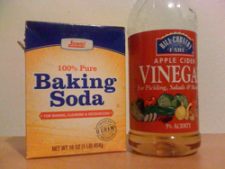How to Add Green to Your Clean

In recent years, you may have started being more aware of whether your actions are ecologically friendly. Most of us are now recycling, and we often try to consolidate errands to use less gas, buy items with less packaging, and otherwise attempt to reduce our carbon footprints. Still, we might be using harsh chemicals when cleaning our homes. The question of what to use for cleaning has a bit of a double edge: On the one hand, we want to use something that’s safe for our families and for the environment, but on the other, we need our clothes, dishes, bathrooms and other household surfaces to actually be clean and as germ-free as possible. If you are looking for effective yet safe ways to clean, here are some ways to green up your household chores:
- Remember that less can be more Whether you’re using commercial or homemade cleansers, using too much is not only less safe for the environment, but it’s likely to make your cleaning less effective. We’ve all made the mistake of using too much cleaning solution when mopping a floor, or have added too much laundry detergent to the washing machine. The sudsy mess left behind just adds more to your cleaning tasks. Be sure to follow dilution instructions carefully, and remember that you don’t necessarily need to make a solution as strong as recommended, particularly if you’re dealing with only a small amount of dirt and grime.
- Use what you have around the house
 You likely have some, if not all, of the ingredients for homemade cleaning solutions in your home. White vinegar, baking soda, washing soda, borax and a mild dishwashing liquid can all go a long way in making sure your home stays clean without resorting to harmful strong chemicals. You can search for ways to make homemade solutions out of these basic ingredients. Some tips: Remember that vinegar and baking soda make a sudsy reaction! This is great to depend on when unclogging pipes (simply pour baking soda and vinegar down the stopped up pipe, wait a few minutes, then follow with a pot of boiling water), but not so great in a spray bottle! A little bit of dishwashing liquid can make a lot of bubbles, so adding just a couple of drops to a bottle full of water, along with a generous splash of vinegar, makes a great multi-purpose cleaning solution. Baking soda can be used the same way you’d use abrasive bleach powder in your bathtub, sink and toilet.
You likely have some, if not all, of the ingredients for homemade cleaning solutions in your home. White vinegar, baking soda, washing soda, borax and a mild dishwashing liquid can all go a long way in making sure your home stays clean without resorting to harmful strong chemicals. You can search for ways to make homemade solutions out of these basic ingredients. Some tips: Remember that vinegar and baking soda make a sudsy reaction! This is great to depend on when unclogging pipes (simply pour baking soda and vinegar down the stopped up pipe, wait a few minutes, then follow with a pot of boiling water), but not so great in a spray bottle! A little bit of dishwashing liquid can make a lot of bubbles, so adding just a couple of drops to a bottle full of water, along with a generous splash of vinegar, makes a great multi-purpose cleaning solution. Baking soda can be used the same way you’d use abrasive bleach powder in your bathtub, sink and toilet. - Choose eco-friendly brands whenever possible If you are buying commercial cleaning products, choose the ones that are labeled “natural,” “eco-friendly,” or “green” if you can. Be sure to read the labels, though, because these descriptive terms don’t necessarily mean that they are good for the environment. You can pick a manufacturer that produces only environmentally friendly products, like Dr. Bronners or Seventh Generation, or you can choose a product made from a mainstream manufacturer, such as All Free and Clear laundry detergent or Clorox GreenWorks.
Remember that even if you're using “safe” products, you will want to store them out of the reach of children. It’s also a good idea to make sure that the room you’re working in is well-ventilated; while vinegar fumes won’t hurt anyone, it’s more pleasant to make them dissipate more quickly. Don’t mix your “green” cleaners with less-green products, either, as harmful gases could be the result. It’s possible to enjoy a clean, sanitary home without using too many dangerous chemicals. Use some of these tips to put the green in your clean and reap the benefits.
